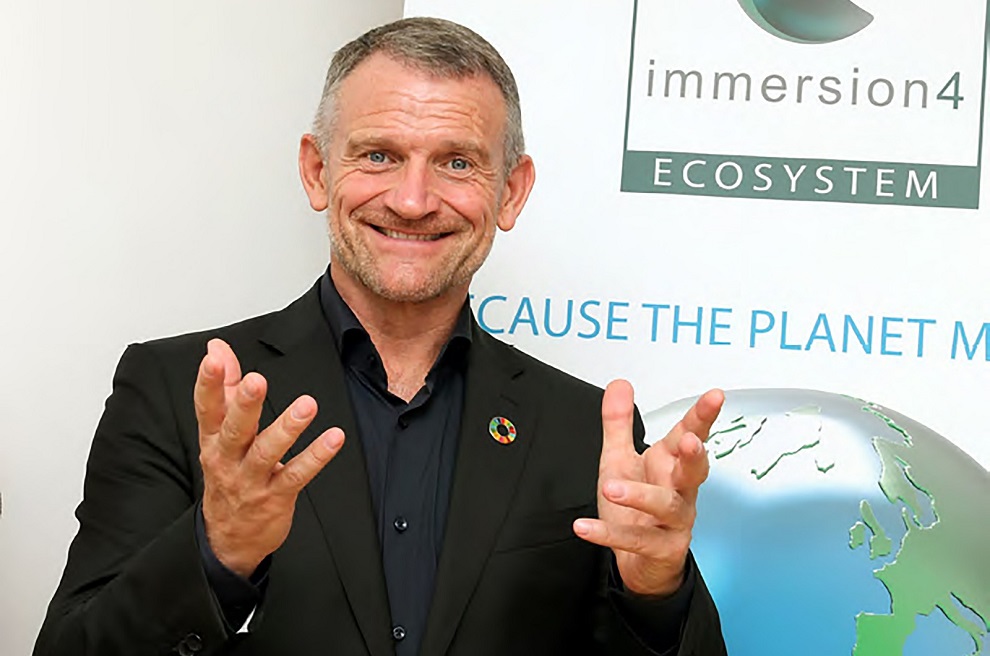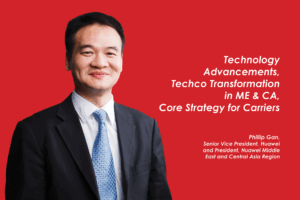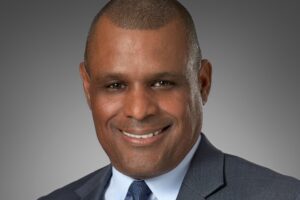Serge Conesa – Founder, Chairman and CEO of Immersion4, speaks to Teletimes about Immersion4’s journey forward as a leader in Immersive Cooling technology
Khalid Athar: Could you describe Immersion4 in simple terms?
Serge Conesa: Immersion4 is about cooling electronics with liquid. We immerse any kind of electronic components along with their connectivity such as power, data and fiber optics in liquid to keep them cool.
KA: How does Immersion4 approach data center cooling?
SC: Cooling datacenter with air, to be honest, does not make a lot of sense. Air is an insulator whereas liquid is a thermal conductor. It is time be back to the principle of exergy and to the root of thermodynamics. The Immersion4 mission is to cool electronics using our liquid called ICETM Coolant while using our open DTMTM systems welcoming any type / any format / any brands of IT Load. In terms of efficiency, there is no better solution than collecting and recycling the digital heat through a “Liquid to LiquidTM” thermal exchange. Since its incorporation, Immersion4 DTMTM technology is based on 4 pillars and 4 principles that answer positively the COP26 & 27 requirements. I always have been convinced that the biggest source of energy we have on earth is what I call “Eco-conservation” aka “powering what matters”. As a matter of fact, we have estimated that if all datacenter’s in the world today will be using Immersion4 technology they will just consume less than 1.5% of the world’s electricity instead of 4% as forecasted for 2030.
Today Immersion4 is 100% SDG, ESG and sharia laws compliant. Our Industrial business model called I4IBMTM (100% based on circular economy) shares the value chain enhancing community quality of life. Immersion4 DTMTM and IBCMinersTM systems allow 1 year ROI with up to 90% TCO. This is a true response to industry needs and ensures the migration to a sustainable data world where energy and infrastructure are used almost exclusively to power the IT load instead of an entire datacenter using air circulation scheme.
Immersion4 DTMTM systems don’t emit any GHG or C02 nor consume any water. In these days of natural resources scarcity and loss of biodiversity, Immersion4 is a true paradigm shift.
Systemic approach is a must to build an eco-conservation society and the e-waste drastic reduction combined with the recycling of what we are producing is mandatory. The planet doesn’t buffer our lifestyle anymore. It is now becoming a question of survival.
KA: What makes the Immersion4 technology unique?
SC: There are many factors that make us unique starting from the company structure to its product series and architectures.
• Immersion4 mission and addressable markets – Immersion4 mission is two-fold. First to address all market segments from SME’s to fortune 500 including private and public. Through circular economy, to help any nation that has a true sustainable agenda. In that regard, we have created our own recyclable product lines and biodegradable liquids. Our go-to market called I4IBMTM “Immersion4 Industrial Business model” creates partnerships with countries allowing our systems to be produced locally as well as creating R&D Labs in partnership with local universities.
• Product offering – Easy and compact. Immersion4 has 2 Series of products called AIO “All In One” and DC “Datacenter” natively designed to reuse the digital heat and to be commissioned without service interruption through modules exchange.
o Both Series are “building block” based designed with a dry compartment for PDU’s and an immersed compartment for servers.
o The “AIO” called “datacenter in the box” has a rack-able integrated cooling module and needs just the electrical and internet connections to be installed in any room.
o The “DC” offers unlimited scalability from EDGE to Hyperscale for any type of datacenter profile.
o Both are managed using the same integrated rack-able MSSTM Management system Immersion4 customers can operate any of our products as soon as they engage with one.
• Business model – It is “Pay as you Grow” based. DTMTM and IBCMinersTM systems can be added in any existing or green field datacenter without any bottleneck expanding with the customer needs.
• IT Load management simplification – Our DTMTM systems are IT load agnostic. The picture above is self-explanatory. Immersion4 “FULL IMMERSION” including fiber connectivity is a clear choice and our DTMTM systems should have no servicing complexity. This is why the customer IT Load can be serviced like an “AIR-Cooled” rack.
KA: Is Immersion4 technology active and deployed at the moment?
SC: Of course. We have been working with various partners around the world. The latest deployment is with BT Group in Ipswich where Immersion4 technology can be seen in full action at the R&D facility.
KA: What is the relative importance of the Middle East market and events like GITEX for Immersion4?
SC: We will be announcing a prime partnership with a local prominent partner to embed our technologies to promote the efficiency of AI and energy to contribute saving what is left of the planet biodiversity and accelerate sustainable data usage at the same time. UAE proves again to be at the forefront of preservation of the planet by adding new emerging technologies.
The Middle East market remains one of the most important markets for ICT around the globe. Immersion4 always has been a strong believer in this market. This region is one of those which will benefit most from Immersion4 technology and as a leader in innovation, I also expect the Middle East market to adapt to newer, and more sustainable technologies at the pace it has continued to do so in the past.
GITEX is certainly an important gathering of ICT leaders and executives. We look forward to meeting our partners at this event and building long-lasting relationships based on the common wish of the betterment of this planet.
KA: How can you relate Immersion4 with AI?
SC: Everybody’s focus today is on AI, which is fundamentally driven by data. The consumption of data is skyrocketing, with exponential growth forecasted from 79 Zettabytes (2021) to 351 Zettabytes in 2030. In this context, sustainability through energy consumption reduction, no pollution and natural resources consumption is key. It’s not only about excelling in AI on the software side, but also about adopting responsible practices in the production and storage of your data. This is precisely what Immersion4 embodies and promotes: leveraging the power of data for good, while ensuring sustainable and ethical data production processes.
Immersive Cooling is closely related to AI because it revolves around the generation of data, which is primarily produced by electronics. To ensure optimal performance, these electronics require efficient cooling methods, and this is where the challenge lies. Traditional air-based cooling used in data centers hinder effective heat dissipation. However, by employing liquid cooling for the entire computer system, we can harness the thermal conductivity of liquids, resulting in a remarkable 80% reduction in energy consumption.
Furthermore, current data centers contribute to environmental issues by emitting CO2, greenhouse gases, micro particles, consuming water at the scale of 1.8 liter per kWh (DOE) and no less than 0.74 liter per GB (Climatiq’s Director of Science Maryam Arbabzadeh ). Immersive cooling addresses this concern by eliminating such pollution and water consumption. Additionally, conventional electronic designs generate significant e-waste, mainly due to cutting and the use of brominated compounds on PCBs. However, with our immersive solutions, the introduction of liquids eliminates the generation of such waste entirely.
Moreover, our groundbreaking approach can already save 30 million lives, and it doesn’t stop there. We aim to establish manufacturing plants worldwide that fully embrace the principles of a circular economy, thereby creating employment opportunities and addressing significant challenges like cool migrations.
Lastly, it’s worth noting that while humans rely on air and water, electronics have no such dependency. In fact, our innovative liquid-based system ensures that electronics remain fully protected and functional without interfering with our vital resources. This way, everyone is content, as our liquid solution perfectly accommodates the needs of electronics while preserving what humans truly require.
KA: How do you see the fact that the data we are storing may or may not be valuable but the energy used to store any data is extremely valuable – yet we continue down the same path?
SC: You are absolutely correct in saying that data may or may not have value but energy has one. I will add to your comment that “Data is Energy” and data should be considered “energy” as without energy there is no data. To be able to achieve and store the massive data production forecasted at around 175 Zettabytes in 2025, we must go back to the electronic fundamentals as data center technology is all about cooling electronics. Electronic optimization must be the first thing that is addressed so any initiative such as algorithms optimization, virtual machine architecture implementation, and application software optimization without that prerequisite cannot be truly efficient.
We are entering an era where data can be considered as the 8th natural resource, and today data centers consume almost 2% of the world’s electricity. Data production implies heat generation. This is where all the Physics laws converge together defining the exchange rules. With the coming end of Moore’s law, new chips will need higher clock speeds to cope with performance demand. Even today’s 4nm bitcoin ASICS require a lot of power capacity and dissipate a tremendous amount of heat (500W+/cm2). The ability to remove high-density heat production, while reducing the electricity used to do this, is the key to performance for various chip industries.
It is obvious that we cannot continue down the same path. Studies and examples are everywhere.
Since 2017, we saw exponential growth in data and a data center market explosion “factories of the digital world”, from EDGE to Hyperscale. Sadly, what we forecasted as worst-case scenarios are becoming reality with a direct impact on our quality of life. Data production will increase from 79 zettabytes in 2021 to 351 zettabytes in 2030 leading from 1.5% to 4% of the world’s electricity consumption and 3.2% of the total GHG emission. “The typical data center uses about 3-5 million gallons of water per day — the same amount of water as a city of 30,000-50,000 people,” said Venkatesh Uddameri, professor and director of the Water Resources Center at Texas Tech University. Microsoft’s giant data center complex in North Holland consumed 84 million liters (84,000 cubic meters) of water in 2021, a year when heat caused severe water shortages. (Drought-stricken Holland discovers Microsoft data center slurped 84m liters of drinking water last year – DCD (datacenterdynamics.com)
KA: What is the key problem in our current approach towards data center cooling?
SC: Cooling electronics using an insulator (air) instead of a thermal conductor (liquid) does not make sense. Trying to reuse the heat dissipated by the IT load through air/liquid is also not efficient and requires huge investment. Often in my presentations, I’m asking if it makes sense to cool an entire room just to cool a glass of champagne. I can see most people smiling. Well, this is what today’s data center technology is about.
We are continuing on “ADDING” and “EXPANDING” this technology with more complicated infrastructure at every level instead of “SIMPLIFIYING” while delivering the same or higher DATA services with respect to Energy consumption and infrastructure.
It is imperative that we change the way we cool electronics which has a lot to do with the way we build data centers. Like any other technology, using the same principles, it just had complexity starting from the IT load supply chain vendors. Cheap liquid technologies, DLC, cold plates,.. don’t solve the data center infrastructure complexity and cost. We need solutions with impact in terms of backup system and UPS reduction, pollution emission, reduction in density and floor space, preservation of natural resources, saving energy and reduction (elimination) of E-waste.
Electronics don’t need air or water to be cooled. In fact, this is where the problem resides, creating many direct and indirect implications such as data center urban integration and costly data center air cooled infrastructure which directly impact ROI and TCO.
The good news is that emerging technologies using immersive cooling are all going one step forward to FULL IMMERSIVE cooling systems.
As a systemic approach, it is key to take into consideration the whole “Heat chain” to:
• Reduce the temperature gradient from the CHIP across the PCB to limit the fatigue related issues thus reducing the life span and improving reliability,
• Increase recycle-ability,
• Effectively reduce energy consumption
Immersion cooling is now inevitable and the new way to cool chips past 500W using warm facility water (25C+) inlet temperatures.
KA: What will be your key focus for the remainder of this year and what do you expect from the industry in the next 18 months?
SC: We are starting active deployment in UAE and internationally in general with well-known customers. We are hoping the industry will soon realize how we help avoid complexity and cost just by being back to the fundamentals. Immersion4 Open Architecture integrates any type of IT load and will become a true problem solver for all types of stakeholders. The future outlook is very promising and we remain motivated to play our role in making the world a better place. A regulatory framework will be required to support more sustainable and responsible stages of open and closed reverse supply chains in the electronics sector but it’s NOT what will make the change. The change will come from the consciousness of each of us and our awareness of what we leave behind for future generations.












